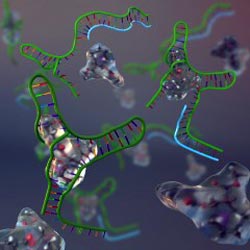Detecting Cocaine “Naturally”

University of Montreal<br> <br>Artist’s rendering: The research team used an existing cocaine biosensor (in green) and revised its design to react to a series of inhibitor molecules (in blue). They were able to adapt the biosensor to respond optimally even within a large concentration window.<br>
Since the beginning of time, living organisms have developed ingenious mechanisms to monitor their environment. As part of an international study, a team of researchers has adapted some of these natural mechanisms to detect specific molecules such as cocaine more accurately and quickly. Their work may greatly facilitate the rapid screening—less than five minutes—of many drugs, infectious diseases, and cancers.
Professor Alexis Vallée-Bélisle of the University of Montreal Department of Chemistry has worked with Professor Francesco Ricci of the University of Rome Tor Vergata and Professor Kevin W. Plaxco of the University of California at Santa Barbara to improve a new biosensing nanotechnology. The results of the study were recently published in the Journal of American Chemical Society (JACS).
Toward a new generation of screening tests
“Nature is a continuing source of inspiration for developing new technologies,” says Professor Francesco Ricci, senior author of the study. “Many scientists are currently working to develop biosensor technology to detect—directly in the bloodstream and in seconds—drug, disease, and cancer molecules.”
“The most recent rapid and easy-to-use biosensors developed by scientists to determine the levels of various molecules such as drugs and disease markers in the blood only do so when the molecule is present in a certain concentration, called the concentration window,” adds Professor Vallée-Bélisle. “Below or above this window, current biosensors lose much of their accuracy.”
To overcome this limitation, the international team looked at nature: “In cells, living organisms often use inhibitor or activator molecules to automatically program the sensitivity of their receptors (sensors), which are able to identify the precise amount of thousand of molecules in seconds,” explains Professor Vallée-Bélisle. “We therefore decided to adapt these inhibition, activation, and sequestration mechanisms to improve the efficiency of artificial biosensors.”
The researchers put their idea to the test by using an existing cocaine biosensor and revising its design so that it would respond to a series of inhibitor molecules. They were able to adapt the biosensor to respond optimally even with a large concentration window. “What is fascinating,” says Alessandro Porchetta, a doctoral student at the University of Rome, “is that we were successful in controlling the interactions of this system by mimicking mechanisms that occur naturally.”
“Besides the obvious applications in biosensor design, I think this work will pave the way for important applications related to the administration of cancer-targeting drugs, an area of increasing importance,” says Professor Kevin Plaxco. “The ability to accurately regulate biosensor or nanomachine’s activities will greatly increase their efficiency.”
References on the study
The research was funded by the Italian Ministry of Universities and Research (MIUR), the Bill & Melinda Gates Foundation Grand Challenges Explorations program, the European Commission Marie Curie Actions program, the U.S. National Institutes of Health, and the Fonds de recherche du Québec Nature et Technologies.
On the Web:
The article Using Distal-Site Mutations and Allosteric Inhibition To Tune, Extend, and Narrow the Useful Dynamic Range of Aptamer-Based Sensors was published in the Journal of the American Chemical Society.
The laboratory of Professor Alexis Vallée-Bélisle: www.nanomachineslab.org
The laboratory of Professor Francesco Ricci: www.francescoriccilab.com
The laboratory of Professor Kevin Plaxco: http://web.chem.ucsb.edu/~plaxcogroup/
Université of Montreal Department of Chemistry : www.chimie.umontreal.ca
Notes: The University of Montreal is officially known as Université de Montréal.
Media Contact
Julie Gazaille
Press Attachée, University of Montreal
+ 1 514 343-6796 j.cordeau-gazaille@umontreal.ca
Media Contact
More Information:
http://www.umontreal.caAll latest news from the category: Life Sciences and Chemistry
Articles and reports from the Life Sciences and chemistry area deal with applied and basic research into modern biology, chemistry and human medicine.
Valuable information can be found on a range of life sciences fields including bacteriology, biochemistry, bionics, bioinformatics, biophysics, biotechnology, genetics, geobotany, human biology, marine biology, microbiology, molecular biology, cellular biology, zoology, bioinorganic chemistry, microchemistry and environmental chemistry.
Newest articles

Solving the riddle of the sphingolipids in coronary artery disease
Weill Cornell Medicine investigators have uncovered a way to unleash in blood vessels the protective effects of a type of fat-related molecule known as a sphingolipid, suggesting a promising new…

Rocks with the oldest evidence yet of Earth’s magnetic field
The 3.7 billion-year-old rocks may extend the magnetic field’s age by 200 million years. Geologists at MIT and Oxford University have uncovered ancient rocks in Greenland that bear the oldest…

Decisive breakthrough for battery production
Storing and utilising energy with innovative sulphur-based cathodes. HU research team develops foundations for sustainable battery technology Electric vehicles and portable electronic devices such as laptops and mobile phones are…





















